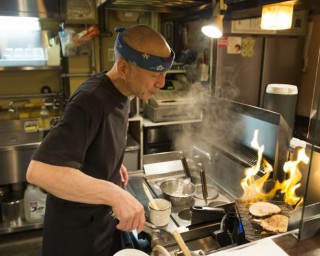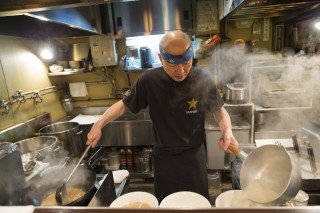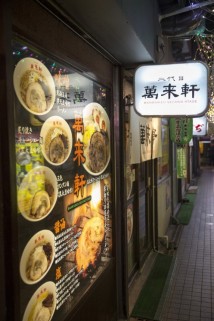Loading
Search
▼ The True Sapporo Ramen Experience
- Category:Experience
I love ramen. Not the instant stuff served in Styrofoam cups, but the fresh noodles served in a bowl of rich soup stock topped with fresh vegetables and slices of pork. I try to eat it several times a month at the various authentic ramen shops across Honolulu. However, as many say, you can only get real New York style pizza in NYC, I believe you can only get real ramen in Japan. And the northern city of Sapporo is the place to get that authentic ramen taste. So during my recent trip to Japan, I made the arduous trek to Hokkaido to eat miso butter ramen.
My Tokyo-born travel buddy, Yoshi, who I met in college in the US, decided to do the ramen travel trip with me. Having him around made it easier to travel to northern Japan as the further away you get from the major tourist cities, the less English you’ll find. Since it would take an entire day to reach Sapporo by train, we opted to take a domestic flight from Tokyo’s Haneda International Airport to New Chitose Airport in Hokkaido.
My Tokyo-born travel buddy, Yoshi, who I met in college in the US, decided to do the ramen travel trip with me. Having him around made it easier to travel to northern Japan as the further away you get from the major tourist cities, the less English you’ll find. Since it would take an entire day to reach Sapporo by train, we opted to take a domestic flight from Tokyo’s Haneda International Airport to New Chitose Airport in Hokkaido.
From there we hopped on the JR Line that took us straight to Sapporo Station in the center of town. The entire trip took us a little over three hours or so. In late Spring 2016, the new Hokkaido Shinkansen High-Speed Rail service will begin and its said it will take under five hours to get to Sapporo. However, flying is much quicker if you don’t have much time.
Once we got into Sapporo, we headed straight to Ramen Yokocho, or Ramen Alley in the Susukino District. The easily found alleyway, lit by a garish street sign, is a mecca for ramen lovers around the world. More an enclosed hallway, Ramen Yokocho boasts about a dozen small restaurants that seat no more than a few customers at a time. Christmas tree lights hang from the ceiling and lanterns illuminate large picture menus of sumptuous bowls of ramen for sale. A looped recording of a charumera, a horn-like instrument once played by ramen pushcart vendors in the old days, echoed throughout the narrow alleyway.
Once we got into Sapporo, we headed straight to Ramen Yokocho, or Ramen Alley in the Susukino District. The easily found alleyway, lit by a garish street sign, is a mecca for ramen lovers around the world. More an enclosed hallway, Ramen Yokocho boasts about a dozen small restaurants that seat no more than a few customers at a time. Christmas tree lights hang from the ceiling and lanterns illuminate large picture menus of sumptuous bowls of ramen for sale. A looped recording of a charumera, a horn-like instrument once played by ramen pushcart vendors in the old days, echoed throughout the narrow alleyway.
With many different varieties to choose from, it was tough to pick the right place to eat. Most places seemed to have the same picture of the same bowl of soup, but Yoshi said they were all very different as the toppings varied from local seafood to pork. He was also undecided so we kept aimlessly wandering around staring at menu after menu. We finally chose a restaurant because the pictures showed huge slices of pork atop bowls of their ramen so we slipped inside Banraiken Second Stage Restaurant.
Chef Kazuyoshi Uchibayashi sang out “Irrashaimase!” in a terse, rather aloof tone as we sat at his tiny L-shaped counter. He placed small water glasses in front of us and quietly stared at us, waiting for us to place our order. There was no small talk or other pleasantries and his face blankly waited for us to place our orders. I squirmed uncomfortably, and after a few seconds of staring at the pictures on his Japanese-only menu, I pointed at a dish. And with a curt “hai,” chef Uchibayashi, whose name was written on a certificate seen on the back wall of the store, began to prepare my first authentic black soy miso butter ramen.
With steam and smoke filling the restaurant, Uchibayashi began to move like an octopus in his tiny kitchen. One-hand woking bean sprouts over a gas flame; another grilling the sumptuous pork over hot coals, all the while keeping an eye on his boiling noodles. He warmed empty soup bowls with hot water, then ladled broth and other ingredients into them. He used no timers or measuring cups, as his precise eye was all he needed. He then pulled the fresh noodles from the boiling water and violently shook them over the sink to drain them.
Chef Kazuyoshi Uchibayashi sang out “Irrashaimase!” in a terse, rather aloof tone as we sat at his tiny L-shaped counter. He placed small water glasses in front of us and quietly stared at us, waiting for us to place our order. There was no small talk or other pleasantries and his face blankly waited for us to place our orders. I squirmed uncomfortably, and after a few seconds of staring at the pictures on his Japanese-only menu, I pointed at a dish. And with a curt “hai,” chef Uchibayashi, whose name was written on a certificate seen on the back wall of the store, began to prepare my first authentic black soy miso butter ramen.
With steam and smoke filling the restaurant, Uchibayashi began to move like an octopus in his tiny kitchen. One-hand woking bean sprouts over a gas flame; another grilling the sumptuous pork over hot coals, all the while keeping an eye on his boiling noodles. He warmed empty soup bowls with hot water, then ladled broth and other ingredients into them. He used no timers or measuring cups, as his precise eye was all he needed. He then pulled the fresh noodles from the boiling water and violently shook them over the sink to drain them.
And as quickly as we had ordered, Uchibayashi placed steaming hot bowls of ramen soup in front of us. My senses were overloaded as the steam fogged my eyeglasses and the smell of the broth overwhelmed me. The large pork loin still sizzled from the grill. Gooey, bright orange boiled egg yolks swam along side bamboo shoots and dumplings.
But as I dipped my spoon into the soup and took my first taste…I was…well…not impressed! I couldn’t taste anything. The flavors seemed so bland and needed something…more salt, chili paste, soy sauce…something…because the soup had no flavor.
Then all of a sudden, the Japanese umami kicked in and I began to taste the complex balance of flavors Chef Uchibayashi had created in his simple bowl of ramen. It was as if my tastes buds had been reborn and I could understand the essence of his ramen.
Growing up in American, my palate is accustomed to gobs of ketchup, glasses of sugary soda, and overwhelmingly salty food. My taste buds are used to immediate gratification. Yet Japanese pride themselves on having an expanded palate and acclaim dishes that blend and balance flavors with each other. Most declare American food to be too bold and Uchibayashi’s soup was clearly a masterpiece in subtleties.
Uchibayashi forced me to taste each ingredient in his ramen and how they affected my difference senses. My mouth filled with the earthy taste of the grass-fed pork. The miso coated my tongue as the savory broth clung to the al dente noodles. I tasted the many hours it took him to create this magical bowl of what I thought was a flavor-less soup.
We noisily slurped our noodles but sat in silence, as we were both overwhelmed with Uchibayashi’s ramen. The chef looked on but also said little as he washed his pots and prepared for another order soon to arrive. Although the bowls were large, we managed to finish the soup and left little behind.
Afterwards, Yoshi translated for me and I asked Chef about his ramen. Uchibayashi, wearing a blue bandana tightly across his forehead, said all of his ingredients were locally sourced in Hokkaido. His vegetables were from a local farm and he purchased his pork from one rancher in Hokkaido because of the particular way the pigs were raised. He tried using imported goods but they failed to extract the flavors he expected from them. He claimed the Japanese ingredients to be superior and he chose to use nothing less. Yet he said his broth wasn’t perfected, although he’s been working on it for most of his adult life.
I asked him how he separates himself from the other shops across the alleyway. He didn’t care much for my question, as it appeared he wasn’t in any competition as his ramen stood on its own. He said other shops have a good product but sometimes the fancier toppings like fresh scallops and shrimp mask the taste of their inferior broths. The broth is what makes his soup better.
He also said he had several apprentices go off and open their own ramen shops but they were not copies of his recipe, as everyone strives to make ramen in their own, unique way.
Uchibayashi bowed politely to us as we paid our bill and as we left his tiny shop, we noticed his faded black tee shirt said in Japanese, “If you’re a real man, shut up and eat ramen.” I chuckled after Yoshi translated that phrase, as I now understood the true taste of ramen. And like that slice of NYC pizza, I would just have to come back to Hokkaido get the real stuff.
by Marco Garcia
But as I dipped my spoon into the soup and took my first taste…I was…well…not impressed! I couldn’t taste anything. The flavors seemed so bland and needed something…more salt, chili paste, soy sauce…something…because the soup had no flavor.
Then all of a sudden, the Japanese umami kicked in and I began to taste the complex balance of flavors Chef Uchibayashi had created in his simple bowl of ramen. It was as if my tastes buds had been reborn and I could understand the essence of his ramen.
Growing up in American, my palate is accustomed to gobs of ketchup, glasses of sugary soda, and overwhelmingly salty food. My taste buds are used to immediate gratification. Yet Japanese pride themselves on having an expanded palate and acclaim dishes that blend and balance flavors with each other. Most declare American food to be too bold and Uchibayashi’s soup was clearly a masterpiece in subtleties.
Uchibayashi forced me to taste each ingredient in his ramen and how they affected my difference senses. My mouth filled with the earthy taste of the grass-fed pork. The miso coated my tongue as the savory broth clung to the al dente noodles. I tasted the many hours it took him to create this magical bowl of what I thought was a flavor-less soup.
We noisily slurped our noodles but sat in silence, as we were both overwhelmed with Uchibayashi’s ramen. The chef looked on but also said little as he washed his pots and prepared for another order soon to arrive. Although the bowls were large, we managed to finish the soup and left little behind.
Afterwards, Yoshi translated for me and I asked Chef about his ramen. Uchibayashi, wearing a blue bandana tightly across his forehead, said all of his ingredients were locally sourced in Hokkaido. His vegetables were from a local farm and he purchased his pork from one rancher in Hokkaido because of the particular way the pigs were raised. He tried using imported goods but they failed to extract the flavors he expected from them. He claimed the Japanese ingredients to be superior and he chose to use nothing less. Yet he said his broth wasn’t perfected, although he’s been working on it for most of his adult life.
I asked him how he separates himself from the other shops across the alleyway. He didn’t care much for my question, as it appeared he wasn’t in any competition as his ramen stood on its own. He said other shops have a good product but sometimes the fancier toppings like fresh scallops and shrimp mask the taste of their inferior broths. The broth is what makes his soup better.
He also said he had several apprentices go off and open their own ramen shops but they were not copies of his recipe, as everyone strives to make ramen in their own, unique way.
Uchibayashi bowed politely to us as we paid our bill and as we left his tiny shop, we noticed his faded black tee shirt said in Japanese, “If you’re a real man, shut up and eat ramen.” I chuckled after Yoshi translated that phrase, as I now understood the true taste of ramen. And like that slice of NYC pizza, I would just have to come back to Hokkaido get the real stuff.
by Marco Garcia
- February 29, 2016
- Comment (0)
- Trackback(0)





